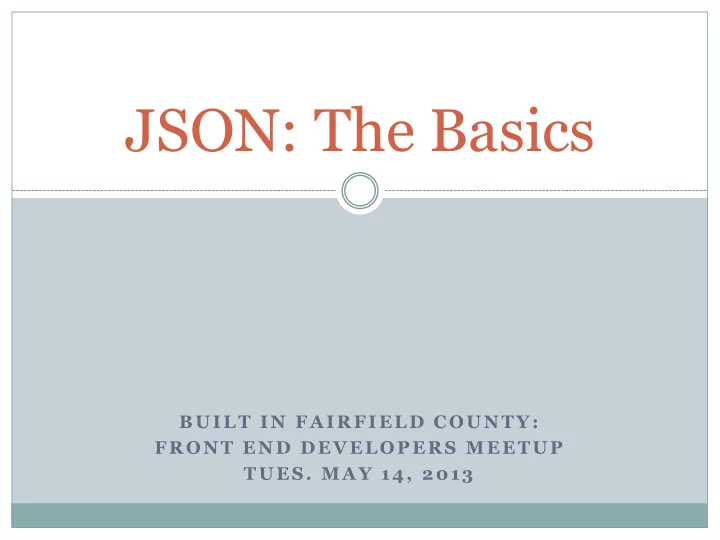

JSON: The Basics BUILT IN FAIRFIELD COUNTY: FRONT END DEVELOPERS MEETUP TUES. MAY 14, 2013
About Jeff Fox (@jfox015) 16 year web development professional (Almost) entirely self taught Has used various Ajax-esque data technologies since 2000, including XML, MS data islands and AMF for Flash Develops JavaScript based web apps that rely on JSON for data workflow
Overview What is JSON? Comparisons with XML Syntax Data Types Usage Live Examples
What is JSON?
JSON is… A lightweight text based data-interchange format Completely language independent Based on a subset of the JavaScript Programming Language Easy to understand, manipulate and generate
JSON is NOT… Overly Complex A “document” format A markup language A programming language
Why use JSON? Straightforward syntax Easy to create and manipulate Can be natively parsed in JavaScript using eval() Supported by all major JavaScript frameworks Supported by most backend technologies
JSON vs. XML
Much Like XML Plain text formats “Self - describing“ (human readable) Hierarchical (Values can contain lists of objects or values)
Not Like XML Lighter and faster than XML JSON uses typed objects. All XML values are type- less strings and must be parsed at runtime. Less syntax, no semantics Properties are immediately accessible to JavaScript code
Knocks against JSON Lack of namespaces No inherit validation (XML has DTD and templates, but there is JSONlint) Not extensible It’s basically just not XML
Syntax
JSON Object Syntax Unordered sets of name/value pairs Begins with { (left brace) Ends with } (right brace) Each name is followed by : (colon) Name/value pairs are separated by , (comma)
JSON Example var employeeData = { "employee_id": 1234567, "name": "Jeff Fox", "hire_date": "1/1/2013", "location": "Norwalk, CT", "consultant": false };
Arrays in JSON An ordered collection of values Begins with [ (left bracket) Ends with ] (right bracket) Name/value pairs are separated by , (comma)
JSON Array Example var employeeData = { "employee_id": 1236937, "name": "Jeff Fox", "hire_date": "1/1/2013", "location": "Norwalk, CT", "consultant": false, "random_nums": [ 24,65,12,94 ] };
Data Types
Data Types: Strings Sequence of 0 or more Unicode characters Wrapped in "double quotes“ Backslash escapement
Data Types: Numbers Integer Real Scientific No octal or hex No NaN or Infinity – Use null instead.
Data Types: Booleans & Null Booleans: true or false Null: A value that specifies nothing or no value.
Data Types: Objects & Arrays Objects: Unordered key/value pairs wrapped in { } Arrays: Ordered key/value pairs wrapped in [ ]
JSON Usage
How & When to use JSON Transfer data to and from a server Perform asynchronous data calls without requiring a page refresh Working with data stores Compile and save form or user data for local storage
Where is JSON used today? Anywhere and everywhere! And many, many more!
Simple Example
Simple Demo Build a JSON data object in code Display raw output Display formatted output Manipulate via form input
Questions?
Resources Simple Demo on Github: https://github.com/jfox015/BIFC-Simple-JSON- Demo Another JSON Tutorial: http://iviewsource.com/codingtutorials/getting- started-with-javascript-object-notation-json-for- absolute-beginners/ JSON.org: http://www.json.org/
Recommend
More recommend